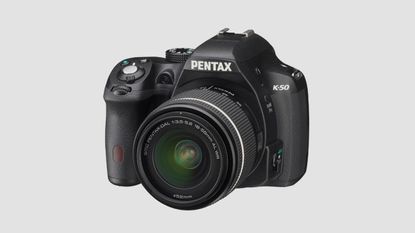The Pentax K-50 is DSLR with 81 weather-resistant seals but can it compete with the likes of Canon, Nikon and Sony?
Pentax has long been in the shadow of Canon and Nikon in terms of the patronage of enthusiasts and pros, and cannot compete with Sony and Panasonic's marketing power. But still it keeps churning out DSLRs that, despite the lack of press or TV ads, are really rather good.
We enjoyed its original oddly named *istD digital SLR a decade ago, and its latest, the 16.28 effective megapixel Pentax K-50, continues a run of largely successful if under the radar offerings.
Like all true DSLRs, Pentax again incorporates a large APS-C CMOS sensor. Punching above its entry-level price tag, it offers an 81 seal weather resistant body like semi professional models such the Nikon D7100.
Another bonus is that the Pentax also features an internal shake reduction sensor shift mechanism to reduce the effects of hand wobble and resultant blur when shooting handheld.
On the likes of Canon and Nikon DSLRs you need to opt for an image stabilised lens instead, whereas any lens on the Pentax immediately becomes stabilised by default.
With the camera costing a reasonable sounding manufacturer's asking price of £599.99 with a standard 18-55mm manual zoom, overall first impressions look promising; but how does the K-50 shape up in use?
Pentax K-50: Controls
Launched alongside the Pentax K-500, the K-50 offers a classic look and design, and looks like any other entry- to mid-level range DSLR. Large well-labelled controls, making it an approachable tool for beginners or simply those with bigger hands, adorn an otherwise frill-free layout.
Perhaps that's why its maker is offering the camera to order in 120 different colour combinations, which allows purchasers to choose a different coloured body, grip, and lens if so wished. But, impressively, the K-50 is actually very fast; both to power up and to determine exposure and focus in the blink of an eye.
However the motor mechanics of the supplied and equally weather-proofed 18-55mm f/3.5-5.6 zoom are noticeably noisier than rival brands, not that this is at all a deal breaker unless you're aiming for candid shots of unsuspecting individuals.
Build quality overall is very good. The 12-option shooting mode dial is stiff with just the right amount of give and features user determinable settings ranged alongside manual and fully auto options, whilst the on/off lever ergonomically encircles the shutter release button.
Pentax K-50: Screen
The 3-inch, 921K-dot resolution screen here is fixed rather than being angle adjustable and the viewfinder is of the regular optical variety. Offering 100% field of view, it is however large and bright in terms of the ease with which shots can be lined up, and offers an equally large and comfortable eye relief.
The LCD menus also offer large and easily navigated displayed icons - indeed they better its rivals here - making this an easy step up DSLR for those wanting better snapshots than a smartphone with a tiny lens and small sensor can manage.
Pentax K-50: Battery
Unusually, the Pentax K-50 differs from most DSLR and interchangeable lens camera rivals such as the Canon EOS 100D and 700D, Nikon D5200, D7100, and Sony SLT-A58 in that as well as the rechargeable lithium battery supplied in the box, which is good for an average 410 shots from a full charge, there is space for four standard AAs should you fall suddenly short of juice.
These are inserted into the base of the handgrip, which as with the likes of the Sony A58 is larger than most. The Pentax's grip provides sufficient space for four fingers whilst your thumb rests on an indent at the back.
Pentax K-50: Picture quality
In terms of shooting Full HD video the built-in microphone is mono rather than stereo, but at least filter effects, such as the ability to shoot in black and white can be accessed for video as well as stills, AF adjusts automatically and swiftly with it, so any alteration in framing or focus doesn't result in a soft image for long.
It's stills where the K-50 excels however, which are superb in terms of colour richness and moreover sharpness, even when the camera is merely equipped with the bog standard 18-55mm zoom lens straight out of the box.
As a prime lens often offers better quality than a zoom, think about twinning the K-50 with the world's smallest fixed focal length lens in Pentax's DA 40mm f/2.8 XS. This offers the equivalent of 61mm in 35mm terms, is just 9.2mm thick and also comes with water and dust repellent coating, suggesting a good match for the similarly featured camera body.
Pentax K-50: Verdict
The Pentax K-50 makes for a good starter option, and we were impressed with the lightning quick speed of its operation at this price point - with auto focus being particularly impressive. However, we did feel that overall the translucent APS-C sensor equipped Sony A58, or indeed Pentax's otherwise very similar K-500 DSLR, offer a slightly better value deal for an entry-level camera.
They offer more bang for your buck if you're not too fussed about the K-50's (admittedly useful) weather sealed capabilities. If you would make use of such a feature, then the K-50 at just under £600 is half the price of weather-sealed semi-pro DSLRs such as the Nikon D7100. That, along with the sharp and colourful digital images it delivers, makes the K-50 a winner in our book.
Pentax K-50 release date: Out now
Pentax K-50 price: £599.99




